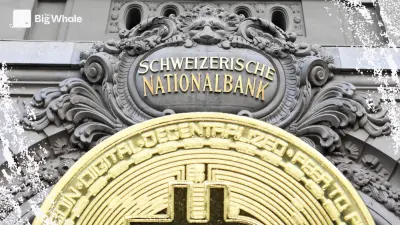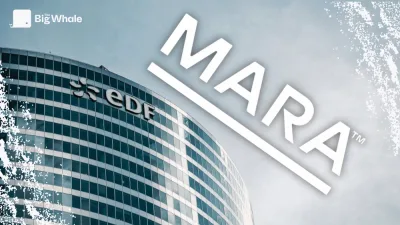TBW - Lombard Finance: Analysis of the leader in BTCFi

The Bitcoin liquid staking (LST) sector is experiencing significant growth. Starting from a market of a few million dollars in June 2024, it reached $4.1 billion in February before stabilising at $2.786 billion. This development indicates a growing interest in the use of Bitcoin in decentralised finance.
Lombard Finance, which represents 64% of the BTC LST market, offers a solution tailored to Bitcoin holders. The company stands out for its security measures, multi-chain use and innovation-friendly ecosystem.
Overview
Despite its dominant position in terms of capitalisation and adoption, Bitcoin remains little used in DeFi. The main obstacles are the lack of native yield, fragmentation of liquidity, lack of integration with DeFi protocols and operating limitations between chains. As a result, more than $1 trillion in Bitcoin remains untapped, unlike assets such as Ethereum.
Created in April 2024, Lombard Finance is responding to these challenges by transforming Bitcoin into a productive financial asset. Its main product, the LBTC, is a token backed by Bitcoin with a 1:1 ratio. The LBTC allows users to generate a return while retaining liquidity and multi-chain compatibility.
Based on the Babylon (read our analysis) infrastructure, considered to be the Bitcoin equivalent of EigenLayer (read our analysis), Lombard Finance is developing a platform that connects Bitcoin holders with proof-of-stake (PoS) networks.
- For PoS networks: the solution enables new blockchains and L2 solutions to use Bitcoin's capitalisation as crypto-economic collateral, replacing traditional staking requirements.
- For BTC holders: Users can generate returns by staking their BTC via Babylon, while retaining liquidity through LBTC usable in various DeFi protocols.
Babylon initiated Bitcoin staking for shared security, but with a constraint: staked BTC remained blocked and inaccessible to DeFi. Lombard solves this problem with three mechanisms:
- Restaking BTC on Babylon to generate yield
- Creating LBTC as a liquid representation of staked BTC
- Access to multi-chain DeFi activities via LBTC (lending, borrowing, yield farming)
Technology and security
.png)
Lombard's technical architecture emphasises security and decentralisation, essential elements for a protocol managing large amounts of Bitcoin.
The Lombard Security Consortium forms the basis of the decentralised infrastructure. The network comprises 14 members, including financial institutions (OKX, Galaxy), validators (Chorus.one, P2P, Kiln, Figment), market makers (Wintermute, Amber Group), mining pools (Antpool, F2Pool) and research partners (Cubist, Nansen, Informal Systems). Together, they validate transactions and oversee governance decisions.
The Consortium operates as a decentralised state machine using the CometBFT consensus mechanism on the Lombard register, a Cosmos chain. The Proof of Authority (PoA) model enables Consortium members to validate transactions transparently. Critical transactions require multiple approvals, with lock-in periods to secure governance decisions.
Main responsibilities include:
- Transaction validation: Verification of Bitcoin deposits and authorisation of LBTC creation
- Staking management: Delegation of staked Bitcoin to Babylon finality providers
- Interchain transfers: Securing LBTC movements via Chainlink CCIP
- Governance: Supervision of protocol updates
The architecture incorporates CubeSigner for multi-signature control and Bascule Drawbridge for protection against piracy. The protocol uses RedStone and Chainlink oracles for price flows and reserve tracking. Audits are carried out by OpenZepplin, Veridise and Halborn, with a bug bounty programme managed by Immunefi.
For risk management, Lombard uses TRM for address filtering and offers full transaction tracking. Transparency is provided by a Proof of Reserve system and a public dashboard on Dune.
Products available
LBTC
Lombard's main product is its liquid staking token, which represents Bitcoin staked via the protocol. It maintains 1:1 parity with Bitcoin.
Lombard currently allows restaking on 4 chains: Ethereum, Base, Binance Chain and Sui.
LBTC is available on 8 chains: Ethereum, Base, Berachain, Binance Chain, Corn, Sonic, Sui and Swell.
The value of the token is tracked by the RedStone oracle system, which calculates the LBTC/BTC price based on the ratio of BTC managed by Lombard to the total LBTC supply on all compatible chains.
Lombard Finance does not have a governance token. The project offers Lux Points via the Luminary Program, which rewards users for staking Bitcoin, holding LBTC and participating in DeFi integrations. These points measure user engagement and could be integrated into future tokenomics. The programme includes special events and Lux multipliers for participation in the ecosystem.
Vaults
Lombard also offers DeFi vaults created in partnership with other players such as Veda, Concrete or Upshift. These vaults are yield management solutions that optimise Bitcoin returns through strategic allocation of deposits across different DeFi protocols..
Staking Yield Pool
Lombard has just launched the Staking Yield Pool, allowing LBTC holders to receive BABY rewards and Bitcoin Secured Networks (BSN) tokens via the Lombard interface.
Revenues
Lombard Finance's revenues come from several sources:
- Staking commissions:
- 10% levy on Babylon staking rewards
- 3-5% commission from finality providers
- Protocol fees:
- Destaking fee set at 0.0001 LBTC per withdrawal
- LBTC creation fee on the various channels
- DeFi vault management:
- Annual commission of 1.5% on assets under management, representing approximately $7.74 million for 2025
- Restaking partnerships:
- Revenue sharing with protocols using LBTC as collateral
- Strategic integrations:
- Commissions from DeFi protocols incorporating LBTC
Financing
In July 2024, Lombard Finance raised $16 million in a funding round led by Polychain Capital. The round brought together a number of investors, including BabylonChain, dao5, Franklin Templeton, Foresight Ventures, HTX Ventures, Mirana Ventures, Mantle EcoFund, Nomad Capital, OKX Ventures and Robot Ventures.
According to data from CB Insights, Lombard recently raised approximately $1 million, bringing its total funding to $17 million.
Team and community
Lombard's founding team brings together decentralised finance experts from blockchain organisations such as Polychain, Babylon, Argent, Coinbase and Maple.
Jacob Phillips, Lombard's co-founder, led product strategy at Perennial Labs and was a partner at Polychain Capital.
The team is based primarily in the UK, with members in the US and UAE.
Polychain Capital's support provides Lombard with resources and expertise in the development of blockchain projects, including strategic advice and an established professional network.
Lombard Finance is developing its presence on social networks:
- X (formerly Twitter): The platform has 48,500 subscribers and regularly shares news
- Discord: The community brings together 25,000 members who exchange views on products and services
- Forums: Lombard participates in DeFi governance discussions, notably via proposals to integrate LBTC on platforms such as AAVE, Morpho, Gearbox and Moonwell
- Documentation: Detailed technical documentation is available to users and developers
- Analytics: A Dune Analytics dashboard allows users to track LBTC's performance on various channels
Partnerships and ecosystem
Lombard has developed a network of partnerships, notably with Babylon for the Bitcoin staking infrastructure. The company collaborates with Veda, Concrete and Upshift for its automated yield vaults.
The LBTC token is integrated into several DeFi platforms such as Gearbox, Morpho Blue, Pendle, EtherFi (read our analysis), Maple Finance, Mizu and Derive.
As a finality provider on Babylon, Lombard delegates more than 22,511 BTC to secure the network. This position enabled it to participate in the launch of Babylon's Genesis chain.
With the rollout of Babylon Phase 3, Lombard plans to extend its services to Bitcoin-Secured Networks such as Corn and BoB.
Competition
While Lombard Finance has positioned itself as a central player in liquid Bitcoin staking on Babylon, other protocols are looking to gain market share in this growing sector:
.png)
Analysis of TVL data in BTC restaking reveals the presence of two main competitors:
- SolvBTC offers a similar range of products with a universal reserve approach. Its coverage is broader than Lombard's, with a presence on Ethereum, BNB Chain, Arbitrum, Avalanche and other networks.
- Lorenzo focuses on a Bitcoin staking solution with deep integration into its ecosystem. Its tokens are available on BNB Chain, SUI and Ethereum.

Beyond the classic risks associated with DeFi protocols (contract vulnerabilities, network attacks, bugs), several points deserve attention:
- Regulatory issues: Like any DeFi protocol, Lombard faces regulatory challenges, particularly regarding AML/KYC compliance
- Liquidity risk: Extreme market events can create a temporary imbalance between supply and demand for LBTC
- Slashing risk: Future mechanisms could result in losses if Babylon validators fail to comply with the rules
- Depeg risk: The 9-day unlocking period may lead to LBTC price variations relative to BTC
The Big Whale's analysis
The Lombard Finance protocol, which seeks to position Bitcoin as a productive asset in the DeFi ecosystem, is attracting attention with a technical architecture based on a Security Consortium bringing together several financial institutions. This model, which aims to reconcile security and decentralisation, contrasts with the single custody solutions usually found in the world of tokenised assets. It does, however, raise questions, particularly in terms of the concentration of power between a small number of players.
The integration of the protocol with Babylon, an infrastructure designed to enable Bitcoin restaking, is a central element of its strategy. It enables BTC holders to generate returns while maintaining the liquidity of their assets on several blockchains. A proposal that aims to address a limitation often pointed out: the difficulty of integrating Bitcoin into decentralised finance logics.
But the next few weeks promise to be decisive in assessing the resilience of the model. Two dates are of particular interest: 24 April and 6 May.
On 17 April, Lombard began an operation to destake its BTC in order to prepare for the transition to a new generation of Finality Providers, and to guarantee access to the first rewards of the Babylon programme. Once the assets have been restacked, the date of 24 April will provide an initial observation point: it will enable the quantity of BTC remaining committed to the protocol to be measured, and thus gauge user loyalty beyond the initial incentives.
6 May will mark a second milestone with the reopening of withdrawals from the Bitcoin Bera Vault, which is currently frozen. User behaviour in the days following this deadline will provide an insight into the true stability of the deposited value (TVL), and help distinguish long-term adherence from possible opportunism linked to rewards programmes and airdrop prospects.
On the technical front, Lombard recently released an SDK designed to facilitate the integration of the LBTC token into wallets and exchange platforms. This development aims to broaden access to Bitcoin-backed staking and DeFi services, by simplifying the interface for end users.
Also, the project team is working hard to maintain a regular link with its community, via public exchanges and a sustained presence on the networks. It's a communications strategy that seems to be helping to anchor the protocol in the crypto ecosystem.
The fact remains that Lombard will still have to go through several stages to establish itself on a lasting basis. The rise of Babylon, withdrawal management, changing economic incentives and competition from other projects in the BTC restaking segment will weigh on its trajectory.



